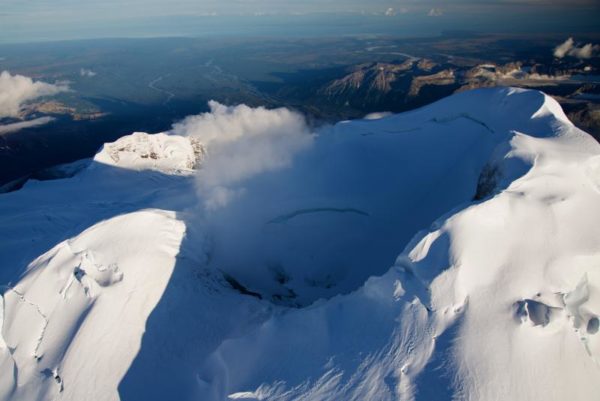
Two companies are looking at the geothermal energy potential of Mount Spurr, an active volcano across the Cook Inlet from Anchorage.
Once they have the final go-ahead from the state, GeoAlaska and Raser Power Systems can explore adjacent leases on Mount Spurr’s south side.
It’s the latest push to harness and develop geothermal energy from the 11,100-foot volcano, a feat no company has accomplished — at least not yet.
The state has held geothermal lease sales for Mount Spurr since the 1980s.
The basic idea of geothermal is to harness heat contained below the earth’s surface, in the form of steam and water. Geothermal is a renewable resource, and like other renewables, can be used to heat homes or generate electricity.
But part of the challenge of developing geothermal at Mount Spurr has been locating the resource, said Steve Masterman, director of the state’s Division of Geological and Geophysical Surveys.
“Understanding the geology is really a key part to that,” he said.
While Mount Spurr is an active volcano, with a lot of trapped, simmering heat, it doesn’t have “clear surface expressions” to indicate where to drill, said Gwen Holdmann, director of the Alaska Center for Energy and Power in Fairbanks.
Gov. Mike Dunleavy’s administration wants to make geothermal exploration in Alaska easier for interested companies, whether it’s at Mount Spurr or elsewhere.
He’s proposed legislation that would, in part, allow companies to lease and explore nearly double the acreage they’re currently allowed.
Masterman said that’d be helpful because surface hot springs often indicate the presence of reservoirs. But the hottest water isn’t always right beneath those springs.
“That might be a number of miles away from the place where it comes out of the ground,” he said.
Dunleavy’s legislation would also extend the maximum exploration period from two years to five.
“It might take a number of summers in order to do the background work, the geology, the geophysics before you do the drawing,” Masterman said. “And then it might take a number of rounds of drilling before you’re successful with finding a viable resource.”
There are other geothermal projects in motion in the state. Chena Hot Springs has its own geothermal plant. And in Unalaska, two companies plan to start constructing a geothermal energy plant this summer for the city’s power grid.
Those plans, and the ones for Mount Spurr, are subject to the state’s current regulations, since Dunleavy’s legislation hasn’t yet passed, and may not before the Legislature adjourns this week.
According to Petroleum News, GeoAlaska, one of the companies looking for a permit, started in 2020 and is based in Anchorage. The other, Raser Power, is based in Utah, and filed for bankruptcy in 2011 in relation to a geothermal plant there.
The companies are hoping to have better luck than those that made previous attempts.
About a decade ago, surveyors tried and failed to find hot water reservoirs at Mount Spurr. Ormat Technologies did surveys and some exploratory drilling there between 2008 and 2011, but later relinquished their leases when it couldn’t locate the resource, according to Holdmann.
“They took a little bit of a conservative approach from the standpoint of drilling in a location that would be more optimal to develop a power plant, and staying a little bit away from any areas that might be close to hazards,” she said.
There is much more land to explore on the volcano, she said. GeoAlaska and Raser can also use data from the prior surveys.
“I am certain that they have looked closely at that data and are using that to rethink the program that they’re developing,” Holdmann said.
Aside from finding the resource, other challenges the companies will have to overcome include expensive up-front costs. Also, Holdmann said, there are regulatory hurdles to development including restrictions from the Alaska Oil and Gas Conservation Commission.
“One thing that we want to be thinking about, in addition to encouraging and promoting exploration, is really thinking about what development might look like,” she said.
Then, there’s the question of a market too, and whether a geothermal project at Mount Spurr is cost-competitive with existing energy sources.
But that’s all years down the road. First, the interested companies need to prove the resource is there — and that they can find it.




